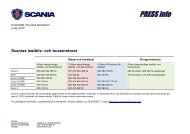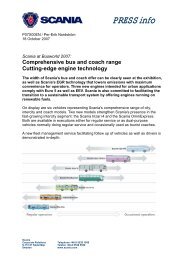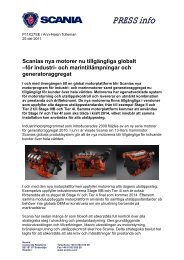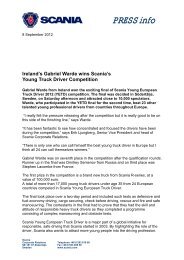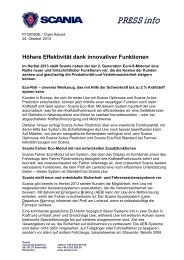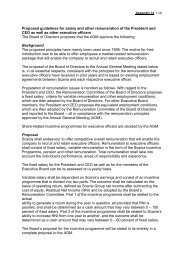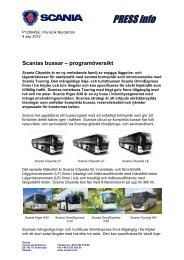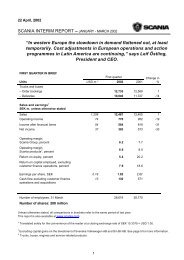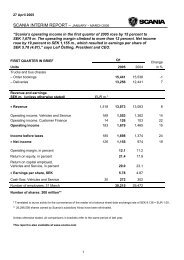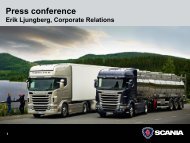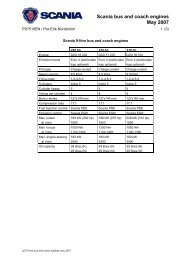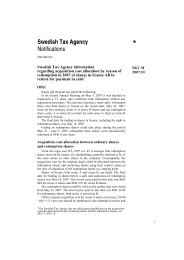Scania Annual Report 2011
Scania Annual Report 2011
Scania Annual Report 2011
You also want an ePaper? Increase the reach of your titles
YUMPU automatically turns print PDFs into web optimized ePapers that Google loves.
SCANIA’S SUSTAINABILITY WORK<br />
51<br />
Continued work is under way to limit the quantity of industrial<br />
run-off water that must be treated. The phosphating<br />
unit in Oskarshamn (Sweden), for example, has reduced the<br />
quantity of run-off water by 90 percent to the current 1 litre<br />
per m 2 of treated sheet metal surface, which is low for a unit<br />
of this type.<br />
As for chemicals, improvement efforts focus on decreasing<br />
their use and transitioning to alternatives with lower<br />
environmental impact.<br />
Better logistics systems<br />
Process development in logistics is profitable, reducing<br />
transport work and thus emissions. This work includes<br />
increasing the load factor for goods shipments and developing<br />
transport systems that support varied goods volume.<br />
Increased use of intermodal shipments, which combine different<br />
modes of transport, often also leads to lower carbon<br />
dioxide emissions.<br />
Carbon dioxide emissions during a<br />
product life cycle<br />
Most of the environmental impact of <strong>Scania</strong> products occurs<br />
when vehicles and engines are in use. A large element of<br />
environmental impact is carbon dioxide emissions.<br />
The production of a <strong>Scania</strong> truck generates around one<br />
tonne of carbon dioxide. Component haulage and vehicle<br />
delivery create another tonne. A long-haulage truck that is<br />
driven fuel-efficiently for 200,000 km per year emits approximately<br />
170 tonnes of carbon dioxide during one year of use.<br />
The big difference in emissions between production and<br />
vehicle use is an important reason for <strong>Scania</strong> to support the<br />
environment work of its customers.<br />
Recycling<br />
Recycling continues to increase, and during <strong>2011</strong>, <strong>Scania</strong><br />
disposed of 83,200 tonnes of waste (excluding foundry<br />
sand), of which nearly 85 percent was utilised for recycling<br />
of materials and recovery of energy. Waste to be sent for<br />
off-site disposal, and mainly classified as hazardous, totalled<br />
8,100 tonnes in <strong>2011</strong>.<br />
In development work, <strong>Scania</strong>’s objective is to reduce the<br />
quantity of waste that is not recyclable, as well as residual<br />
products, so they can be treated and recycled. <strong>Scania</strong><br />
provides detailed dismantling and disposal protocols for<br />
end-of-life treatment of vehicles. Many parts are designed<br />
for recycling and are labelled for easy identification.<br />
Environmental performance in the production network<br />
<strong>2011</strong> 2010 2009<br />
Number of vehicles produced 83,987 67,567 35,698<br />
Net sales, SEK m.<br />
<strong>Scania</strong> products 87,686 78,168 62,074<br />
Raw material consumption<br />
Per vehicle, kg 2,500 2,500 2,300<br />
Total, tonnes 214,000 168,000 80,500<br />
Total, SEK m. 2,480 1,950 970<br />
Chemical consumption<br />
Per vehicle, m 3 0.088 0.089 0.098<br />
Total, m 3 7,350 6,000 3,500<br />
Total, SEK m. 277 238 133<br />
Energy use<br />
Per vehicle, MWh 7.7 9.7 14.0<br />
Total, GWh 649 652 500<br />
Total, SEK m. 385 385 315<br />
Carbon dioxide emissions<br />
Goods transports, 1,000 tonnes 145 102 56<br />
Fossil fuels, 1,000 tonnes 32 35 25<br />
Purchased electricity, 1,000 tonnes 41 37 29<br />
Purchased heat, 1,000 tonnes 6.2 9.4 7.0<br />
Per vehicle, tonnes 2.7 2.7 3.3<br />
Of which facility-related 0.9 1.2 1.7<br />
Total, 1,000 tonnes 225 183 117<br />
Water use<br />
Per vehicle, m 3 6.5 7.7 12.8<br />
Total, 1,000 m 3 546 520 460<br />
Total, SEK m. 7 6 6<br />
Solvent emissions<br />
Per vehicle, kg 4.0 3.9 4.5<br />
Total, tonnes 333 270 160<br />
Recycling of residual products<br />
and waste<br />
Per vehicle, kg 840 830 890<br />
Total, tonnes 70,800 56,000 32,000<br />
Revenue, SEK m. 125 91 29<br />
Sent to landfills and other<br />
off-site disposal<br />
Per vehicle, kg 150 150 220<br />
Total, tonnes 12,400 9,900 7,800<br />
Total, SEK m. 28 22 16<br />
Emissions from goods shipments were calculated as specified by the Network for<br />
Transport and Environment (NTM). An in-depth account of measures and results as<br />
well as a summary of environmental performance by production unit are available at<br />
www.scania.com. The website has not been reviewed by the company’s auditors.<br />
<strong>Report</strong> of the directors <strong>Scania</strong> <strong>2011</strong>



